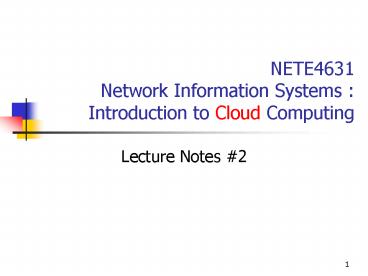NETE4631 Network Information Systems : Introduction to Cloud Computing - PowerPoint PPT Presentation
1 / 24
Title:
NETE4631 Network Information Systems : Introduction to Cloud Computing
Description:
NETE4631 Network Information Systems : Introduction to Cloud Computing Lecture Notes #2 * * * ... – PowerPoint PPT presentation
Number of Views:336
Avg rating:3.0/5.0
Title: NETE4631 Network Information Systems : Introduction to Cloud Computing
1
NETE4631Network Information Systems
Introduction to Cloud Computing
- Lecture Notes 2
2
Recap - Network Information Systems (NIS)
- NIS is an information system for managing
networks. - Examples
- Grid-based application
- telecommunications network
- Mail services, www
- Cloud-based application
3
Transformation of Data to information
Feedback
4
What is Cloud Computing?
- Cloud computing is a model for enabling
convenient, on-demand network access to a shared
pool of configurable computing resources (e.g.,
networks, servers, storage, applications, and
services) that can be rapidly provisioned and
released with minimal management effort or
service provider interaction. (A definition by
the US National institute of standards and
technology (NIST)) - Some of the characteristics
- Distributed computing at a massive scale
- On demand elasticity
- Exploiting existing technologies (Grid, Utility,
Virtualization) - Pay per use model
- Driven by economies of scale
5
Market Forecast
6
Main Aspects of a Cloud System
7
What is different?
- Scale -Some companies that rely on cloud
computing have infrastructures that scale over
several (or more) data centers, Amazon YouTube - Simplicity simpler computing APIs
- Pricing pay as you use and No upfront capital
expenditure from investment to operational cost
8
What is different? (2)
- Availability of infinite computing resources on
demand to follow the load surges eliminating the
need for planning far ahead for provisioning - No requirements for an up-front commitment and
enabling companies to start small and increase
resources only when the need increases - The ability to pay for use of computing resources
on a short-term basis as needed (for example,
processors by the hour and storage by the day)
and release them as needed, thereby rewarding
conservation by letting machines and storage go
when they are no longer useful.
9
Cloud Characteristics
- Non-Functional Aspects
- Elasticity Horizontal and vertical scalability,
middleware capable of automatic integration and
extraction of extra resources when required. - Reliability -No loss of data, no code reset
during execution etc. - Quality of Service -Specific requirements MUST be
met by the service provider, e.g., response time,
throughput etc. - Agility and adaptation meeting the requirements
of new or different resources on the fly - Availability of services and data masking
failures
10
Cloud Characteristics
- Economic Aspects
- Cost reduction Reducing the cost for
infrastructure acquisition and maintenance - Improved time to market Imperative for SMEs.
Larger enterprises can publish new capabilities
with little overhead to remain competitive. - Return on investment Essential but not
guaranteed - Turning CAPEX into OPEX from capital cost to
operation cost model - Going Green Reducing the energy consumption of
unused resources scaling up should also consider
the carbon footprint
11
Service and Deployment Models
12
Common Elements of a Cloud
13
Is Cloud Computing for Me?
- For end users
- Cost reduction From capital investment to
operational expense (pay-per-use) - Ease of use via standardized mechanisms, e.g.
Browser - Flexibility and short time-to-result
- Services providers
- Reduction of the entrance barrier
- Reduction of time to market
- Private Cloud
- Maximize the utilisation of computing resources
- Minimize operational costs and the organisation
keeps full control of its data centres
14
Benefits of Cloud Computing
- On-demand self-service
- Broad network access
- Resource pooling
- Rapid elasticity
- Measured service
- Lower costs
- Ease of utilization
- Quality of Service
- Reliability
- Outsourced IT management
- Simplified maintenance and upgrade
- Low barrier to entry
15
Some of the Challenges!!!
- Security
- Would my data be more secure with Cloud provider?
- Interoperability
- Significant risk of vendor lock-in Standardized
interfaces not available, incompatible
programming models - Reliability
- Use of commodity hardware, prone to failure
...Cloud 2.0 - Laws and regulations
- Privacy, security, and location of data storage
- Organizational changes
- Changing authorities of IT departments,
compliance policies - Cost
- Purchase vs. Lease, migration cost, models to
design capital and operational budgets, cost of
cloud providers
16
Some Public Cloud Providers
- Amazon
- Azure Service Platform
- Salesfoce.com (CRM systems)
17
Amazon Web Services (AWS)
- Elastic Compute Cloud (EC2) Virtual machines and
CPU cycles - Simple Storage Service (S3) Virtual storage
service - Simple Queue Service (SQS) Message passing API
- SimpleDBRunning queries on structured data in
real time works with EC2 and S3
18
Google App Engine
19
Windows Azure
- Windows Azure Service hosting and management,
storage, computation, networking - Microsoft SQL Services Database services and
reporting - Microsoft .NetServices Service-based
implementation of .NET framework
20
A Comparative
21
References
- Armbrust, M., et al., 2010, A View of Cloud
Computing, ACM, 53(4), pp. 50-58. - Zhang, Q., Cheng, L., Boutaba, R., Cloud
Coomputing state-of-the-art and research
challenges, Journal of Internet Services and
Applications, 2010, 17-18. - The Future of Cloud Computing Opportunities for
European Cloud Computing Beyond 2010.
22
Exercise
- Put some NISs in your company as well as their
characteristics (Application support, input,
processing, output) into Levels of management
below.
23
Characteristics of each level of management
support
24
- THANK YOU!!!!!































